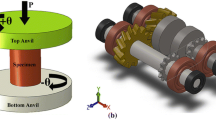Abstract
During the production of torsion bars, two different mechanical processes of inducing the residual stresses into the torsion bar are used: the presetting of the torsion bar and the deep rolling of the torsion bar. The process of presetting the torsion bar is carried out by twisting the torsion bar to the desired angle and releasing it to the new residual angle position. With controlled overstraining, favorable residual shear stresses are induced into the torsion bar, so the material is strain hardened and the yield point of the material is shifted and increased in the stress and strain space. The objective of the deep rolling process is to introduce compressive residual stresses into near-surface regions in order to increase the fatigue strength of the torsion bar. These two processes influence each other. The final level of residual stresses depends on the production sequence of these two processes and the production parameters of each process. The correct production sequence of these two operations and distribution of beneficial residual stress was simulated using the finite element (FE) method. To validate this model, the predicted surface residual stresses were compared by the X-ray diffraction (XRD) measurements of residual stresses.




















Similar content being viewed by others
References
Almen J (1951) Torsional Fatigue Failures. Prod Eng 22:167–182
Swift W a C (1976) On the scragging of circular section bars and tubes. J Strain Anal Eng Des 11:69–77. doi:10.1243/03093247V112069
Eerden RL Van, Cambell K, Holly ML, et al. (2000) Manual on Design and Manufacture of Torsion Bar Springs and Stabilizer Bars, SAE HS-796. SAE International
Altenberger I, Scholtes B, Martin U, Oettel H (1999) Cyclic deformation and near surface microstructures of shot peened or deep rolled austenitic stainless steel AISI 304. Mater Sci Eng A 264:1–16. doi:10.1016/S0921-5093(98)01121-6
Schulze V (2006) Modern mechanical surface treatment. Wiley-VCH Verlag GmbH & Co., Weinheim
Swift W a C (1978) On the measurement of residual shear stress in scragged torsion bars. J Strain Anal Eng Des 13:157–163. doi:10.1243/03093247V133157
Fujczak R (1991) Correlation between Machine Twist Angle and Unit Twist Angle in Calculating Shear Stresses for Elastic and Plastic Strains in Torsion
Kim HS (2001) Finite element analysis of torsional deformation. Mater Sci Eng A 299:305–308. doi:10.1016/S0921-5093(00)01416-7
Brabie G (2003) An analysis of the shearing stresses distribution on the cross-section of the twisted round bars. J Mater Process Technol 142:224–230. doi:10.1016/S0924-0136(03)00584-3
Rees DW a (2009) Descriptions of reversed yielding of a solid circular bar in torsion. Proc Inst Mech Eng Part C J Mech Eng Sci 223:557–571. doi:10.1243/09544062JMES919
Wang H, Rui Q, He X (2007) The prediction technology study of fatigue life for key parts of a tracked vehicle’s suspension system. Front Mech Eng China 2:68–71. doi:10.1007/s11465-007-0011-0
Skalski K, Morawski A, Przybylski W (1995) Analysis of contact elastic–plastic strains during the process of burnishing. Int J Mech 37:461–472
Guagliano M, Vergani L (1995) Residual stresses induced by deep rolling in notched components. Trans Eng Sci 8:109–119
Mayer HM, Achmus C, Pyzalla A (2000) Increase of fatigue strength of crankshafts by deep-rolling and induction hardening induced beneficial residual stress states - experimental determination and FEM simulation. Mater Week 2000:1–9
Demurger J, Forestier R, Kieber B, Lasne P (2006) Deep rolling process simulation: impact of kinematic hardening on residual stresses. Proc ESAFORM 1–5
Majzoobi GH, Azadikhah K, Nemati J (2009) The effects of deep rolling and shot peening on fretting fatigue resistance of Aluminum-7075-T6. Mater Sci Eng A 516:235–247. doi:10.1016/j.msea.2009.03.020
Bäcker V, Klocke F, Wegner H et al (2010) Analysis of the deep rolling process on turbine blades using the FEM/BEM-coupling. IOP Conf Ser Mater Sci Eng 10:1–10. doi:10.1088/1757-899X/10/1/012134
Manouchehrifar A, Alasvand K (2012) Finite element simulation of deep rolling and evaluate the influence of parameters on residual stress. 5th WSEAS Int. Conf. Cambridge, pp 61–67
Balland P, Tabourot L, Degre F, Moreau V (2013) An investigation of the mechanics of roller burnishing through finite element simulation and experiments. Int J Mach Tools Manuf 65:29–36. doi:10.1016/j.ijmachtools.2012.09.002
Trauth D, Klocke F, Mattfeld P, Klink A (2013) Time-efficient Prediction of the Surface Layer State after Deep Rolling using Similarity Mechanics Approach. Procedia CIRP 9:29–34. doi:10.1016/j.procir.2013.06.163
Werke M (2009) Simulation of manufacturing sequences for verification of product properties. KTH, Stockholm
Afazov S (2009) Simulation of manufacturing processes and manufacturing chains using finite element techniques. The University of Nottingham
Altenberger I (2005) Deep Rolling—The Past, the Present and the Future. Proc 9th Int Conf Shot Peen 144–155
Klocke F, Bäcker V, Wegner H (2009) Influence of process and geometry parameters on the surface layer state after roller burnishing of IN718. Proc Natl Acad Sci U S A. doi:10.1007/s1
Klocke F, Shirobokov A, Mattfeld P, Feuerhack A (2014) Festwalzen von Feinschneidstempeln. Werkstattstechnik 104:660–665
Chaboche JL (2008) A review of some plasticity and viscoplasticity constitutive theories. Int J Plast 24:1642–1693. doi:10.1016/j.ijplas.2008.03.009
Lemaitre J, Chaboche J (1990) Mechanics of solid materials. Cambridge University Press, New York
Kunc R, Prebil I (2003) Low-cycle fatigue properties of steel 42CrMo4. Mater Sci Eng A 345:278–285. doi:10.1016/S0921-5093(02)00464-1
Yang M, Akiyama Y, Sasaki T (2004) Evaluation of change in material properties due to plastic deformation. J Mater Process Technol 151:232–236. doi:10.1016/j.jmatprotec.2004.04.114
Sun G-Q, Shang D-G (2010) Prediction of fatigue lifetime under multiaxial cyclic loading using finite element analysis. Mater Des 31:126–133. doi:10.1016/j.matdes.2009.06.046
Nalla R, Altenberger I, Noster U et al (2003) On the influence of mechanical surface treatments—deep rolling and laser shock peening—on the fatigue behavior of Ti–6Al–4 V at ambient and elevated temperatures. Mater Sci Eng A 355:216–230. doi:10.1016/S0921-5093(03)00069-8
Acknowledgments
The authors would like to thank Sistemska tehnika d.o.o., Slovenia, for their support throughout this research.
Author information
Authors and Affiliations
Corresponding author
Rights and permissions
About this article
Cite this article
Perenda, J., Trajkovski, J., Žerovnik, A. et al. Modeling and experimental validation of the surface residual stresses induced by deep rolling and presetting of a torsion bar. Int J Mater Form 9, 435–448 (2016). https://doi.org/10.1007/s12289-015-1230-2
Received:
Accepted:
Published:
Issue Date:
DOI: https://doi.org/10.1007/s12289-015-1230-2




